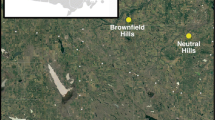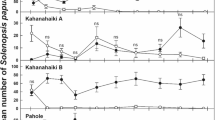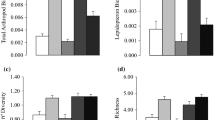Abstract
Secondary foundation species facilitate biodiversity by providing complex habitat within the protective structures of many primary foundation species; whether they retain this role when they are dispersed in novel environments is unclear. Here, we explore how secondary foundation species’ density within hosts controls the rate at which individuals accrue and test if dislodged secondary foundation species then bolster the abundance and diversity of associated species and decomposition in a widespread system: southern live oaks, Quercus virginiana, hosting festoons of the bromeliad, Tillandsia usneoides, in southeastern US savannas. One year of monitoring showed that as Tillandsia density within oaks increases, Tillandsia deposition beneath oaks increases linearly in kind. Once on the ground, two manipulative experiments revealed that: on small scales, individual festoons retain moisture, reduce temperature, and facilitate invertebrates and fungi which combine to accelerate litter decomposition and, on larger scales, continual deposition of festoons dramatically reduces grass cover and increases litter layer depth, invertebrate and fungi richness and density, and decomposition. Surveys further suggest that Tillandsia populations within oaks, in moderating festoon accumulation, are shaping understory communities throughout this geographic region. Thus, disturbance-induced spillover enables secondary foundation species to define biodiversity and ecosystem functioning beyond the boundaries of their hosts.




Similar content being viewed by others
REFERENCES
Altieri A, Silliman B, Bertness M. 2007. Hierarchical organization via a facilitation cascade in intertidal cordgrass bed communities. Am Nat 169:195–206.
Altieri AH, van de Koppel J. 2014. Foundation species in marine ecosystems. In: Bertness MD, Bruno JF, Silliman BR, Stachowicz JJ, Eds. Marine ecology and conservation, Vol. 1. Boston: Sinauer. p 50–65.
Angelini C, Altieri AH, Silliman BR, Bertness MD. 2011. Interactions among foundation species and their consequences for community organization, biodiversity, and conservation. BioScience 61:782–9.
Angelini C, Silliman B. 2014. Secondary foundation species as drivers of trophic and functional diversity: evidence from a tree-epiphyte system. Ecology 95:185–96.
Bates D, Maechler M, Bolker B. 2012. lme4: Linear mixed-effects models using S4 classes. R package version 0999999-0.
Bishop M, Byers J, Marcek B, Gribben P. 2012. Density-dependent facilitation cascades determine epifaunal community structure in temperate Australian mangroves. Ecology 93:1388–401.
Bruno JF, Bertness MD. 2001. Habitat modification and facilitation in benthic marine communities. In: Bertness MD, Gaines S, Hay M, Eds. Marine community ecology. Sunderland: Sinauer. p 201–16.
Bruno JF, Stachowicz JJ, Bertness MD. 2003. Inclusion of facilitation into ecological theory. Trends Ecol Evol 18:119–25.
Burnham KP, Anderson DR. 2002. Model selection and inference: a practical information-theoretical approach. 2nd edn. New York: Springer.
Byers J, Gribben P, Yeager C, Sotka E. 2012. Impacts of an abundant introduced ecosystem engineer within mudflats of the southeastern US coast. Biol Invasions 14:2587–600.
Callaway RM, Reinhart KO, Moore GW, Moore DJ, Pennings SC. 2002. Epiphyte host preferences and host traits: mechanisms for species-specific interactions. Oecologia 132:221–30.
Chapin FI, Matson P, Mooney H. 2002. Principles of ecosystem ecology. New York: Springer.
Criquet S, Ferre E, Farnet A, Le petit J. 2004. Annual dynamics of phosphatase activities in an evergreen oak litter: influence of biotic and abiotic factors. Soil Biol Biochem 36:1111–18.
Dayton PK. 1972. Toward an understanding of community resilience and the potential effects of enrichments to the benthos at McMurdo Sound, Antarctica. In: Proceedings of the colloquium on conservation problems in Antarctica. Lawrence, KS: Allen Press.
Díaz I, Sieving K, Peña-Foxon M, Armesto J. 2012. A field experiment links forest structure and biodiversity: epiphytes enhance canopy invertebrates in Chilean forests. Ecosphere 3:5.
Díaz IA, Sieving KE, Peña-Foxon ME, Larraín J, Armesto JJ. 2010. Epiphyte diversity and biomass loads of canopy emergent trees in Chilean temperate rain forests: a neglected functional component. Forest Ecol Manag 259:1490–501.
Dijkstra JA, Boudreau J, Dionne M. 2012. Species-specific mediation of temperature and community interactions by multiple foundation species. Oikos 121:646–54.
Ellwood MDF, Foster WA. 2004. Doubling the estimate of invertebrate biomass in a rainforest canopy. Nature 429:549–51.
Fulbright T, Garza A. 1991. Forage yield and white-tailed deer diets following live oak control. J Range Manag 44:451–5.
Garth R. 1964. The ecology of Spanish moss (Tillandsia usneoides): its growth and distribution. Ecology 45:470–81.
Gribben P, Byers JE, Wright JT, Glasby TM. 2013. Positive versus negative effects of an invasive ecosystem engineer on different components of a marine ecosystem. Oikos 122:816–24.
Kohler L, Holscher D, Leuschner C. 2008. High litterfall in old-growth and secondary upper montane forest of Costa Rica. Plant Ecology 199:163–73.
Matelson T, Nadkarni N, Longino J. 1993. Longevity of fallen epiphytes in a neotropical montane forest. Ecology 74:265–9.
Nadkarni N, Matelson T. 1991. Fine litter dynamics within the tree canopy of a tropical cloud forest. Ecology 72:5–6.
Nadkarni N. 1992. Biomass and nutrient dynamics of epiphytic litterfall in a neotropical montane forest, Costa Rica. Biotropica 24:24–30.
Nadkarni NM, Schaefer D, Matelson TJ, Solano R. 2004. Biomass and nutrient pools of canopy and terrestrial components in a primary and a secondary montane cloud forest, Costa Rica. Forest Ecol Manag 198:223–36.
Nadkarni NM. 1984. Epiphyte biomass and nutrient neotropical elfin forest. Biotropica 16:249–56.
Osenberg C, Sarnelle O, Cooper S. 1997. Effect size in ecological experiments: the application of biological models in meta-analysis. Am Nat 150:798–812.
R Core Development Team. 2014. R: A language and environment for statistical computing.
Rousk J, Nadkarni NM. 2009. Growth measurements of saprotrophic fungi and bacteria reveal differences between canopy and forest floor soils. Soil Biol Biochem 41:862–5.
Songwe N. 1988. Litterfall and productivity in a tropical rain forest, Southern Baakundu Forest Reserve, Cameroon. J Trop Ecol 4:25–37.
Stachowicz JJ. 2001. Mutualism, facilitation, and the structure of ecological communities. BioScience 51:235.
Strong DR. 1977. Epiphyte loads, tree falls, and perennial forest disruption: a mechanism for maintaining higher tree species richness in the tropics without animals. J Biogeogr 4:215–18.
Takada M, Baba Y, Yanagi Y. 2008. Contrasting responses of web-building spiders to deer browsing among habitats and feeding guilds. Environ Entomol 37:938–46.
Tanner EVJ. 1980. Litterfall in montane rain forests of Jamaica and its relation to climate. J Ecol 68:833–48.
Thomsen MS, McGlathery K. 2006. Effects of accumulations of sediments and drift algae on recruitment of sessile organisms associated with oyster reefs. J Exper Marine Biol Ecol 328:22–34.
Thomsen MS, McGlathery KJ, Schwarzschild A, Silliman BR. 2009. Distribution and ecological role of the non-native macroalga Gracilaria vermiculophylla in Virginia salt marshes. Biol Invasions 11:2303–16.
Thomsen MS, Wernberg T, Altieri A, Tuya F, Gulbransen D, McGlathery KJ, Holmer M, Silliman BR. 2010. Habitat cascades: the conceptual context and global relevance of facilitation cascades via habitat formation and modification. Integr Comp Biol 50:158–75.
Veneklaas EJ. 1991. Litterfall and nutrient fluxes in two montane tropical rain forests, Colombia. J Trop Ecol 7:319–36.
Watson DM, Herring M. 2012. Mistletoe as a keystone resource: an experimental test. Proc R Soc B 279(3853–60):14.
Wigglesworth V. 1945. Transpiration through the cuticle of insects. J Exper Biol 21:97–115.
Acknowledgements
We thank the Sapelo Island National Estuarine Research Reserve for access to sites, KB Gedan, MJS Hensel and BR Silliman for comments on the manuscript, EE Knight and R Atkins for assistance with fieldwork. Research was supported by NSF GRFP (DEB 00084143) and UF Graduate Alumni Fellowships awarded to C. Angelini.
Author information
Authors and Affiliations
Corresponding author
Additional information
Author contributions
Both CA and KLB designed experiments, performed research, analyzed data, and wrote the paper.
Electronic supplementary material
Below is the link to the electronic supplementary material.
Rights and permissions
About this article
Cite this article
Angelini, C., Briggs, K.L. Spillover of Secondary Foundation Species Transforms Community Structure and Accelerates Decomposition in Oak Savannas. Ecosystems 18, 780–791 (2015). https://doi.org/10.1007/s10021-015-9862-0
Received:
Accepted:
Published:
Issue Date:
DOI: https://doi.org/10.1007/s10021-015-9862-0




